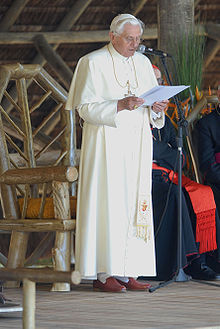Thefasciais asashworn byclericsandseminarianswith thecassockin theRoman Catholic Churchand in theAnglican Church.It is not worn as a belt but is placed above the waist between the navel and the breastbone (sternum). The ends that hang down are worn on the left side of the body and placed a little forward but not completely off the left hip.

Etymology
editFasciareis the Latin word for to bind or wrap. This meaning of binding together shows a significance of the fascia keeping thecassocktight to the cleric. It furthermore shows that the wearer is bound together in a permanent state of life and incontinence.Thelaw of graceand life in Christ bind together, hold together, the man, who before and without these, is unbound, not put together, not altogether whole. Because the cleric is bound to and bycontinence,he is able to serve the Church freely and give of himself freely as Christ Jesus did.
Use
editThe fascia is not avestment,but is part ofchoir dressand is also used in more solemn everyday dress.[citation needed]
Colours
editThepope's fascia iswhite.Only thepopemay have hiscoat of armsplaced on the ends of the fascia that hang down near or past the knees. The fascia worn bycardinalsisscarlet-redwatered silk.Fascia ofpurplewatered silk are worn bynuncioswithin the territories assigned to them.[1]Plain (not watered)purplefascia are worn bypatriarchs,archbishopsandbishopswho are not cardinals, and also byprotonotaries apostolic,honorary prelates,andchaplains of the Pope,these three being the different ranks ofmonsignors,from highest to lowest. However, the Eastern Catholic patriarchs have been allowed to wear scarlet fascia in their choir dress at times, especially beforeVatican II,even when they were not also cardinals.Blackfascia are worn bypriests,deacons,seminarians,andacolytesand the fascia worn by priests in the service of the Papal Household is black watered silk.[citation needed]
Forms
editPrior to the changes that followed theSecond Vatican Councilthere were two types of fascia: thetuftedfascia, on which each end was finished in a single large tassel, and thefringedfascia, on which each end is straight and finished with fringe. The InstructionUt sive solliciteof theSecretariat of State,dated 31 March 1969,[2]declared that "the sash with tassels is abolished" for cardinals,[3]bishops,[4]and "Prelate Superiors of theDicasteriesof theRoman Curiawho do not have the episcopal dignity, theAuditorsof theSacred Roman Rota,the Promotor General of Justice and theDefender of the Bondin theSupreme Tribunal of the Apostolic Signatura,theProtonotaries Apostolicde numero,the Clerics of theApostolic Cameraand the Prelates of the Pontifical Antechamber ".[5]This Instruction did not deal withcanons,[6]some few of whom have retained the tufted sash to which membership of their particularchapterentitled them.[citation needed]
References
edit- ^InstructionUt sive sollicite,32
- ^Text of the Instruction in English, published byL'Osservatore Romano
- ^Instruction, 3
- ^Instruction, 15
- ^Instruction, 18
- ^Instruction, 35